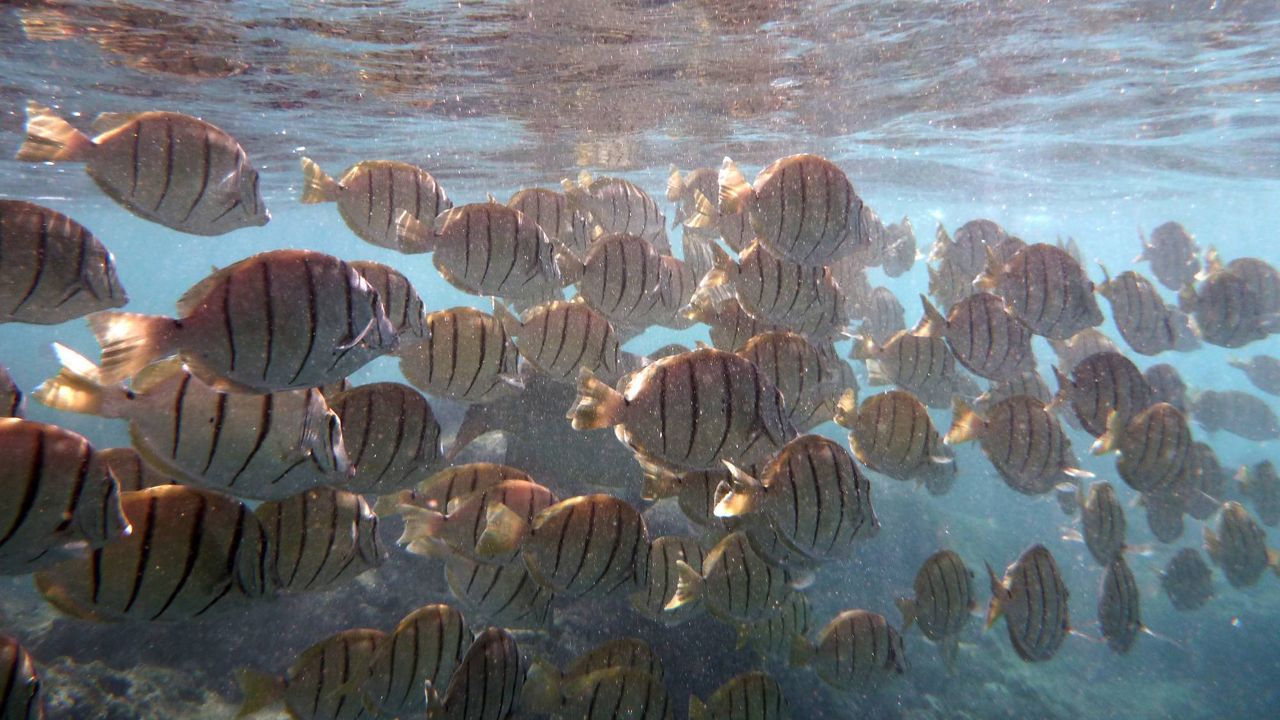The Department of Land and Natural Resources recently held three virtual sessions to get public input on proposed fishing rules that aim to protect reef fish and the marine ecosystem statewide.
These sessions by the Division of Aquatic Resources were held to collect community input regarding proposed amendments to update the Statewide Herbivore Management Strategy.
Hawaii’s coral reef system, as with many reef systems around the world, has been affected by a variety of threats, scientists have said. Warming oceans, sea-level rise, changes in storm patterns and precipitation, altered ocean currents and ocean acidification are all brought on by climate change that drastically affects coral reef ecosystems, according to the National Oceanic and Atmospheric Administration.
To address concerns about coral reef health and fish populations statewide, DAR is proposing updates to the management strategy that include limiting the number or size of fish depending on the type of fish caught at one time.
“Protecting the herbivores is trying to help out the habitat, help out the coral,” said Ryan Okano, according to local media reports. Okano is DAR program manager of ecosystem protection. “This act of preserving the herbivores kind of buys us time. It helps override some of these impacts too, like everybody is worried about the sediment hurting the reef — a healthy herbivore population makes the reef more resilient and it helps the reef handle this kind of pressure, such as bad water quality.”
Other threats include the use of non-mineral sunscreens that contribute to poor water quality. They include chemicals such as octinoxate, octocrylene and oxybenzone.
In the summer of 2018, Gov. David Ige signed a legislative bill into law that banned the sale of over-the-counter sunscreens with the chemicals. The measure went into effect on Jan. 1, 2021. At the time, Hawaii was the first state to pass such a law to protect the marine environment and made news nationwide.
In a joint news release by Maui County Councilmember Kelly Takaya King announced Nov. 19, the Maui County Council unanimously passed Bill 135 that prohibits the sale, distribution and use of non-mineral sunscreens. The bill was signed into law as Ordinance 5306 by Maui Mayor Michael Victorino on Dec. 16 and will take effect on Oct. 1, 2022.
Healthy reef systems are crucial to the economy as a natural and cultural resource, as well as a source of food for many, the DLNR said. Keeping the reef system in good health and the herbivorous fish population at a sustainable level is key.
“One study estimated the nearshore fishery provides more than seven million meals each year to Hawaii families,” according to the DLNR.
It also said that herbivorous fish living among the reef primarily feed on algae or plants, and includes uhu (Parrotfish), kala (Unicornfish), manini (Convict Tang), kole (Goldring Surgeonfish) and others. When herbivores feed on algae, they help maintain and prevent algal populations from overgrowing and overtaking marine organisms such as corals. This allows space for corals to settle and grow, thus contributing to reef recovery and resilience in the face of threats such as climate change.
Herbivorous fish are also a critical component in perpetuating healthy reefs and feeding local communities. Being able to carefully manage and maintain a sustainable population of fish leads to food security and protection of coral reefs.
Key actions in the management plan include implementing place-based and statewide regulations to promote sustainable fishing practices, enhancing monitoring efforts to track changes and evaluate effectiveness of management measures and collaboration with partners to better address land-based impacts, according to the DLNR.
Native Hawaiian Kelson “Mac” Poepoe is a lifelong Molokai resident well versed in the ways of subsistence fishing learned from his parents and the generations before them. Poepoe has dedicated his life to caring for Moomomi and Kawaaloa bays through the community management organization, Hui Malama O Moomomi, and knows the rocky crags and shoreline like the back of his hand. He was also featured in PBS Hawaii’s “Pacific Heartbeat, Na Loea: The Masters II,” about individuals who are masters of aspects of Hawaiian culture.
He said there are many challenges managing natural resources.
“Reef fish management and regulations have been a very complicated issue for the DAR/DOCARE (Division of Conservation and Resources Enforcement) and all state agencies involved with trying to find solutions to problems that the kanaka maoli (full-blooded Native Hawaiian) had figured out long ago. Much of what is already known by the kanaka maoli somehow does not fit the criteria of state regulations, management and enforcement.
“We must eat,” he continued. “The need to learn how to malama (care for) cannot be accomplished by closing off an area for prolonged periods of time. Spawning was the exception. When I think of management, I like to think of the thousands of kanaka (individuals) who were born with kuleana (responsibility, jurisdiction) and how being pono (correct, moral, just) wasn’t something you try to do or be — it was automatic. Malama the aina (land)! One heart,” he said.






